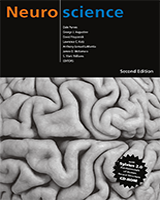By agreement with the publisher, this book is accessible by the search feature, but cannot be browsed.
NCBI Bookshelf. A service of the National Library of Medicine, National Institutes of Health.
Purves D, Augustine GJ, Fitzpatrick D, et al., editors. Neuroscience. 2nd edition. Sunderland (MA): Sinauer Associates; 2001.

Neuroscience. 2nd edition.
Show detailsMost taste stimuli are nonvolatile, hydrophilic molecules soluble in saliva. Examples include salts such as NaCl needed for electrolyte balance; essential amino acids such as glutamate needed for protein synthesis; sugars such as glucose needed for energy; and acids such as citric acid that indicate the palatability of various foods (oranges, in the case of citrate). Bitter-tasting molecules include plant alkaloids, such as atropine, quinine, and strychnine, that may be poisonous. Placing bitter compounds in the mouth usually deters ingestion unless one “acquires a taste” for the substance, as for quinine in tonic water.
The taste system encodes information about the quantity as well as the identity of stimuli. In general, the higher the stimulus concentration, the greater the perceived intensity of taste. Threshold concentrations for most ingested tastants are quite high, however. For example, the threshold concentration for citric acid is about 2 mM; for salt (NaCl), 10 mM; and for sucrose, 20 mM. Since the body requires substantial concentrations of salts and carbohydrates, taste cells may respond only to relatively high concentrations of these essential substances to promote an adequate intake. Clearly, it is advantageous for the taste system to detect potentially dangerous substances (e.g., bitter-tasting plant compounds) at much lower concentrations. Thus, the threshold concentration for quinine is 0.008 mM, and for strychnine 0.0001 mM. As in olfaction, gustatory sensitivity declines with age. Adults tend to add more salt and spices to food than children. The decreased sensitivity to salt can be problematic for older people with electrolyte and/or fluid balance problems. Unfortunately, a safe and effective substitute for NaCl has not yet been developed.
There are at least two common misconceptions about taste perception. The first is that sweet is perceived at the tip of the tongue, salt along its posterolateral edges, sour along the mediolateral edges, and bitter on the back of the tongue. This arrangement was initially proposed in 1901 by Deiter Hanig, who measured taste thresholds for NaCl, sucrose, quinine, and hydrochloric acid (HCl). Hanig never said that other regions of the tongue were insensitive to these chemicals, but only indicated which regions were the most sensitive. People missing the anterior part of their tongue (or who have facial nerve lesions) can still taste sweet and salty stimuli. In fact, all of these tastes can be detected over the full surface the tongue (Figure 15.11A). However, different regions of the tongue do have different thresholds. Because the tip of the tongue is most responsive to sweet-tasting compounds, and because these compounds produce pleasurable sensations, information from this region activates feeding behaviors such as mouth movements, salivary secretion, insulin release, and swallowing. In contrast, responses to bitter compounds are indeed greatest on the back of the tongue. Activation of this region by bitter-tasting substances elicits protrusion of the tongue and other protective reactions that prevent ingestion. Sour-tasting compounds elicit grimaces, puckering responses, and massive salivary secretion to dilute the tastant.
A second misconception about taste perception is that there are only four “primary” tastes: salt, sweet, sour, and bitter. If this were true, then all tastes could be represented as a combination of these “primaries.” Although these four tastes do indeed represent distinct perceptions, this classification is obviously limited. People experience a variety of additional taste sensations, including astringency (cranberries and tea), pungency (hot pepper and ginger), fat, starchy, and various metallic tastes (to name but a few). None of these, however, fits into these four categories. Moreover, some cultures consider other tastes to be “primary.” For example, the Japanese consider the taste of monosodium glutamate to be distinct from that of salt, and even give it a different name (“umami,” which means delicious). Finally, mixtures of various chemicals may elicit entirely new taste sensations. While it is possible to estimate the number of perceived odors (approximately 10,000), these uncertainties have made it difficult to estimate the number of tastes. In neither taste nor olfaction is there a clear relationship between “primary” perceptual classes and the cellular and molecular machinery of sensory transduction.
- Taste Perception in Humans - NeuroscienceTaste Perception in Humans - Neuroscience
Your browsing activity is empty.
Activity recording is turned off.
See more...